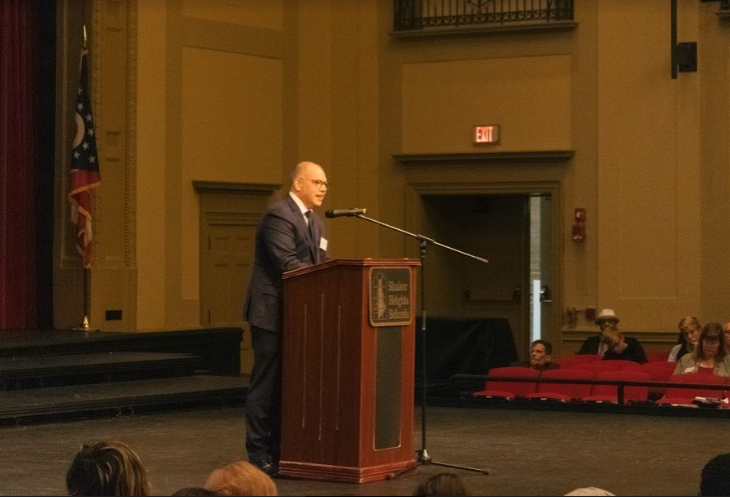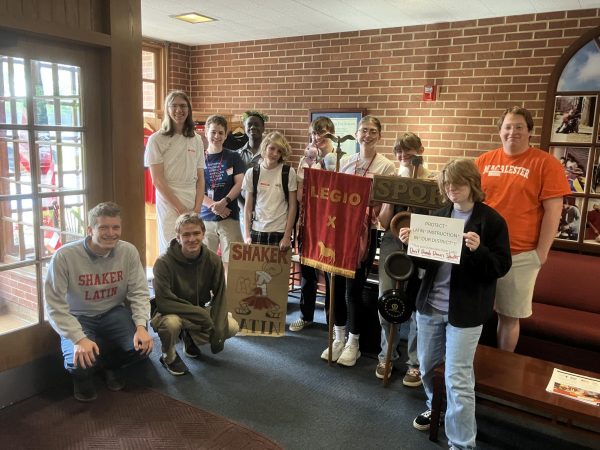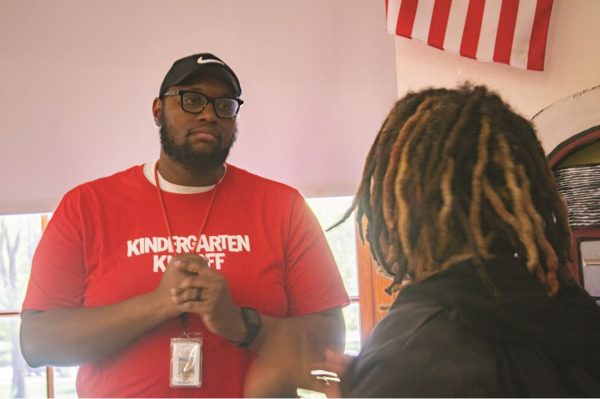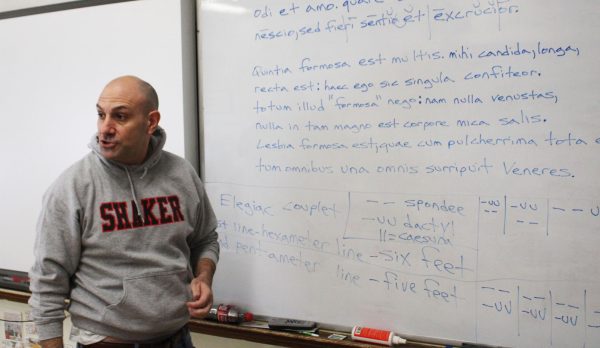Hall of Fame Inductees Reflect on Their Time at Shaker
Inductee Joshua Levy speaks to students at the hall of fame assembly.
The most recent alumni chosen by the Shaker Schools Foundation for induction into the Shaker Heights High School Hall of Fame exhibit the potential of Shaker students after graduation. From a professional football player to an undersecretary in the Navy, the eight 2019 inductees demonstrate the diverse ways Shaker graduates can make a difference beyond high school.
The Hall of Fame comprises 290 Shaker graduates who are pioneers in the fields of health and medicine, law and justice, arts and culture, government and athletics. High school students had the opportunity to hear from the inductees in an assembly Oct. 11 in the high school’s large auditorium.
“I got out of it that people can graduate from Shaker and take a bunch of different paths,” sophomore Sam Sekeres said. “It’s not all like everyone does the same thing. There was a ton of variety, which I thought was really interesting.”
“Mr. Levin is such an influential person,” said senior Adewe Stovall, who introduced James Levin (’71) at the assembly. “I’ve done stuff at Cleveland Public Theatre, I’ve participated in their STEP program, and I participated in Pandemonium, which is like their huge fundraiser for the year, so I mean, it’s nice to be able to meet the person behind that.”
Said Stovall, “Hopefully, this will be me one day!”
Elle O’Brien
Nate Clements, 1998
“Being consistent in what you have a passion for will allow you to reach your goal,” Nate Clements told an audience of upperclassmen during the Hall of Fame assembly Oct. 11.
Clements starred for the Shaker Heights football team, which qualified for the playoffs twice and in 1997 won the Lake Erie League Championship. While at Shaker, he played quarterback and defensive back, and he still holds the school record for interceptions with 14. In 2005, the Shaker Heights Athletic Association retired his jersey, number 20.
Clements was drafted by the Buffalo Bills in 2001 after playing cornerback for The Ohio State University. He also played cornerback for the San Francisco 49ers from 2007-2010 and the Cincinnati Bengals from 2011-2012. He played 12 seasons in the National Football League.
During his speech, Clements recounted his efforts to remain eligible for athletics and to get into college. “I wasn’t a straight-A student by far. I got mostly B’s, but I worked just as hard — academically, I worked just as hard — just so I could play football,” he said.
“I took the SAT six or seven times. I took the ACT once, and I knew that I would keep on trying,” he said. Clements explained that he woke at 5 a.m. every morning while in high school, prepared breakfast for himself and his mother and came to the high school to work out before class. He said he practiced only briefly with his team after school so that he could attend SAT tutoring classes.
In an interview after the speech, Clements explained how he balanced academics and athletics. “I had to sacrifice a lot of luxury, [and] time,” he said, “sacrifice going to the latest parties, going to hang out.”
Clements has four children and has volunteered for charitable organizations such as the HeartBright Foundation, which promotes cardiovascular health, and the Leukemia and Lymphoma Society. He also partnered with Habitat for Humanity to build a playground at Peabody Elementary School in San Francisco.
“Just being there is important,” he said in an interview after the speech.
Clements concluded his speech with a message to seniors. “It goes by fast,” he said. “And before you know, you are out on your own, out in the real world.”
Ari Green, Chethan Chandra and Ruth Wilson
Barbara Fisher, 1972
Barbara Fisher spoke on the importance of connections between people and the lack of such connections today.
“Stories bring people together, movies bring people together,” said Fisher, who is currently executive vice president of Reel One Entertainment, a production and distribution company in Los Angeles.
In an interview after the assembly, Fisher said she found her interest in theater and the arts in high school. She participated in the theatre program, student council and a creative magazine club and was interested in politics. She said these activities led to her interest in becoming a producer.
Before joining Reel One Entertainment, Fisher was vice president of entertainment for both the Lifetime and Hallmark TV networks. In the interview, Fisher mentioned she also worked with Universal, where she loved the exciting environment. At Universal, she oversaw hits including “Just Shoot Me” for NBC and The WB Television Network’s “The Steve Harvey Show,” which later became a huge success.
In her speech Fisher also remarked often on the importance of stories to the world. She encouraged students to maintain connections with teachers and other adults after graduation. Fisher said, “Stories, people, discussions — that’s what makes life wonderful.”
Marin Hunter and Annie Sullivan
Kristen VanValkenburg Destigter, M.D., 1980
Kristen VanValkenburg Destigter, M.D, is imaging the world.
She is a radiologist who graduated from Shaker Heights High School in 1980 and later created the nonprofit organization Imaging World. It is dedicated to instructing African nurses in the use of ultrasound, which is a diagnostic test that produces images of organs in the body, commonly used for pregnancies.
Destigter spoke about her work in the field of radiology and in parts of Africa at the Hall Of Fame assembly Oct. 11 in the high school’s large auditorium.
She has conducted more than 300,000 ultrasound scans, trained hundreds of nurses, and affected or saved the lives of many. She also has been teaching radiology for nearly two decades, and has taught at the University of Vermont since 2000.
Along with her teaching position and work with Imaging World, DeStigter is also the chairwoman of the radiology department at the University of Vermont Larner College of Medicine.
She described her interest in medicine from an early age. “I was always interested in medicine,” DeStigter said in an interview after the assembly. “I didn’t know for sure that I was interested in radiology until I got pretty far through my medical school career.”
Destigter always knew wanted to give back somehow or do something good after reaching a certain point of success. “I got to my real job as a radiologist, and then thought that there’s got to be something more than this that I can do with my skills, and my talent, and my experience,” she said in an interview after the assembly. She explained that the idea to help in Africa occurred when working on infectious parasites, one of which was common in Sub-Saharan Africa, bringing her to study in Kenya.
“We developed the drug, that’s now the drug of choice, for one of those parasitic infections,” Destigter said in the interview. “We could track how that drug was being effective by looking at the results of what we see inside the body with ultrasound.” The use of ultrasound during this study lead to the realization that far too many African nurses did not have or know how to use ultrasound equipment, which is necessary to ensure safe and healthy pregnancies and prevent other issues.
She said in the assembly that 25 percent of the time, other problems were found in the body when looking at a pregnancy. However, she also explained that ultrasound is used to find issues unrelated to pregnancy, like parasitic infections or any disease or organ problems.
A common pregnancy issue detected with ultrasound is the incorrect position of the baby in the womb, mostly meaning whether the baby will come out head-first or feet-first. It also detects any basic abnormalities.
Ultrasound may not always be 100 percent accurate, but it is a safe way for the pregnant mother and her child to be monitored, as well as to ensure the general health inside the body in any situation. After discovering that many people do not have access to ultrasound, DeStigter took action to make a change. She also has another connection to the Shaker: Her mother, Carol VanValkenburg, is a retired SHHS English teacher for whom she expressed admiration and thanks during her speech.
Evan Barragate, Cheyanne Thornton and Karthik Chandra
_________________________________________________________________________________
Lorna Hartling, 1983
“What doesn’t kill you or break you down will make you stronger,” violist Lorna Hartling, 54, said at the Hall of Fame assembly Oct. 11.
Hartling, who is African American, told the audience that her career as a violist began with nothing but a small apartment in Germany and a job selling programs in a blue suit for two Euros. When she finished selling programs, she would sneak into concerts to see the orchestra, which, she said, was filled with all blonde, white people.
“I wanted to do something that has never been done before,” she said. Hartling wanted to become the first African American violist in the Deutsche Symphonie Orchester Berlin.
Hartling, who said she wanted to become a violist so she could get a good job, then decided to audition for the orchestra and got in. “I’m very happy with where I am right now,” she said.
In an interview after the assembly, Hartling said she started out playing the piano but hated it. Then, she wanted to play the trumpet, but her father wouldn’t let her, and she loved playing harmonies so she decided to play viola. She said her parents were also musicians. Hartling started playing viola at age 13 and began playing professionally at 17.
Julia Loveman, Abby Sable, and Sy’Rai Bloodworth
_________________________________________________________________________________
Eugenie Kleinerman, M.D., 1967
The message Dr. Eugenie Kleinerman got from her first choice for medical residency was not encouraging.
“I don’t think women belong in medicine,” she was told years ago.
Gender discrimination did not stop her, though, and she completed a general pediatric residency at a different facility, Children’s National Medical Center in Washington D.C.
Kleinerman’s path to oncological research in children was not her intention, but her calling. During her speech, she explained that she was moved by a film about a pediatric cancer patient, and upon leaving the theater, knew that she had to direct her efforts to help such patients. This experience motivated Kleinerman’s rise in her field, and she eventually became both Head of the Division of Pediatrics and Chair of the Department of Pediatrics at The University of Texas MD Anderson Cancer Center from 2001-2015.
At MD Anderson, Dr. Kleinerman researched ways to treat adolescent sarcoma, a rare cancer that grows in connective tissues and quickly spreads to other tissues in the body. She is globally recognized for leading a new treatment in children’s cancer that uses an immune system protein in the body called MTP-PE to fight the cancerous cells without harming other cells. The immunotherapy she developed is used in 35 countries and has reduced the adolescent mortality rate by 30 percent, she said.
In an interview after the assembly, Kleinerman said some form of the idea that medical professions belong to men was commonly fed to her outside of the Shaker community. Nevertheless, she said, she always knew that medicine was her calling, but not always cancer research. She graduated from Duke University medical school in 1975 and ultimately subspecialized in pediatric oncology, or children’s cancer, in conclusion of her fellowship at the National Cancer Institute in Bethesda, MD.
Her new calling is research in preventive measures on the cardiac, or heart related, side effects of chemotherapy. In the interview, Kleinerman told the story of a cancer patient she cured. The patient collapsed and died of heart failure in the middle of a basketball game, a fate caused by the chemotherapy he had received. This was “very emotionally moving” news for Kleinerman, and it has inspired her ongoing research.
“If something drives you, moves you, grabs you, stop and listen to it,” she said during the interview.
In the past with pediatric sarcoma research, and with her current study of cardiac effects of cancer treatment, Dr. Kleinerman’s message is the same. She concluded her speech by stating, “If you know in your heart that your idea truly has value, don’t listen to naysayers. And become a cookie cutter, not just a beautiful cookie.”
Jaimee Martin and Zariel Nixon
_________________________________________________________________________________
James Levin, 1971
James Levin spoke of taking risks and making a change. “You can create change and still function within structure,” Levin said.
After attending law school at Case Western Reserve University, Levin moved to New York City. There, he discovered his love for theater. He joined the avant-garde La MaMa Experimental Theatre Club and became a resident company member. He returned to Cleveland inspired by the type of theater La MaMa produced and founded Cleveland Public Theatre.
The 1971 Shaker graduate described himself as a “rebel.” Levin wasn’t involved in Shaker until he became an avid member of student council, starting several clubs and activities, including an all-day music seminar.
“Because of student politics, I become more sensitive to social conditions and political conditions in the community. I was inspired to try to have some impact on it,” Levin said during an interview after the assembly.
For more than 20 years, Levin served as the Executive and Artistic Director at the Cleveland Public Theatre. His work there focused on giving a voice to at-risk men and women. He saw the CPT as a chance to develop downtown Cleveland. Levin also founded the annual Ingenuity Festival and co-founded the Gordon Square Arts District.
Levin has devoted his life to making change and he now motivates young people to do the same. Said Levin, “Take risks, go out of your comfort zone, and be willing to fail.”
Lillian Potiker, Maurice Lewis and Helene Aandal
_________________________________________________________________________________
Joshua Levy, 1990
“Struggle, and do the best you can,” said Joshua Levy, co-founder of Cunningham Levy Muse LLP.
An attorney, Levy has assisted in many high profile international cases, such as the involvement of French officials in the Rwandan Genocide, the UK bribery act and the investigation of Russian interference in the 2016 election.
“When our clients come to us, they are usually in a world of hurt, and we’re constantly reminding our team that it does no good to say we’re surrounded; we have to be creative and undeterred,” Levy told the audience during the assembly.
Domestically, Levy co-led an investigation for the Major League Baseball Association. Before co-founding Cunningham Levy Muse LLP in 2014, he served as counsel to the U.S. Senate Committee on Homeland Security and Governmental Affairs, as well as U.S. Sen. Charles S. Schumer.
According to his website, he also specializes in cybersecurity cases. Levy said that, in the span of only one year, he and his team can spend thousands of hours just researching their many clients. “Law is the study of human experience,” Levy said.
After mentioning the impact of the Student Group on Race Relations on his life, Levy said, “The ability of our firm to run investigations in Rwanda, in Washington D.C., in London, in Paris doesn’t happen without the background and the dynamics that I appreciated and learned from the Student Group on Race Relations here at Shaker.”
Levy also noted the role The Shakerite and former adviser Sally Schwartz play in his success. “Today in my professional life, I’m frequently speaking with reporters, editors, producers and major media organizations, to help educate them about the accuracies or inaccuracies of their stories as they affect my clients,” Levy said. “I walk in to those conversations confident about what their role is in large part because of the education in journalism I received on the second floor of this building.”
Levy said, “Live some life first before going to law school, because as a lawyer you need human experience to help your career. Pay rent, get a job, see your friends get arrested, try not to get arrested yourself, then settle down for law.”
Adrik Dutta, Reece Turner and Elise Boyd
_________________________________________________________________________________
Thomas Modly, 1979
“Nothing is more precious than choosing openness to other people. You can do this by demonstrating repeatedly the willingness to show love to strangers, even when you’re not even sure that person needs it.”
Shaker graduate Thomas Modly, now undersecretary of the U.S. Navy, spoke on the importance of kindness and open-mindedness as he was honored at the Hall of Fame Induction Assembly Oct. 11. The undersecretary is the second highest-ranking position in the Navy.
After graduating from Shaker in 1979, Modly attended the prestigious U.S. Naval Academy. Applicants to U. S. military academies must be appointed by their senators to gain admission. Modly spent seven years as an officer in the Navy and served on active duty as a helicopter pilot. He left active duty in 1990 to pursue a degree in business from Harvard University.
Modly said that he was very fortunate to have grown up in Shaker, where he learned about different people and cultures. He said he had friends at Shaker from different backgrounds, and many people he met at the Naval Academy didn’t have that growing up. Modly said that Shaker accepted him for who he was and helped him grow and learn from a young age.
Modly spoke about the importance of kindness and benevolence in his speech. He encouraged Shaker students to open their hearts to strangers, and emphasized how showing good will toward others will open doors for people.
After the assembly, he said, “Try to open your heart to somebody different every day, someone you don’t know. It will enrich your life.”
Anna Welsh, Jayvion Cunningham and Alexandrea Dean









